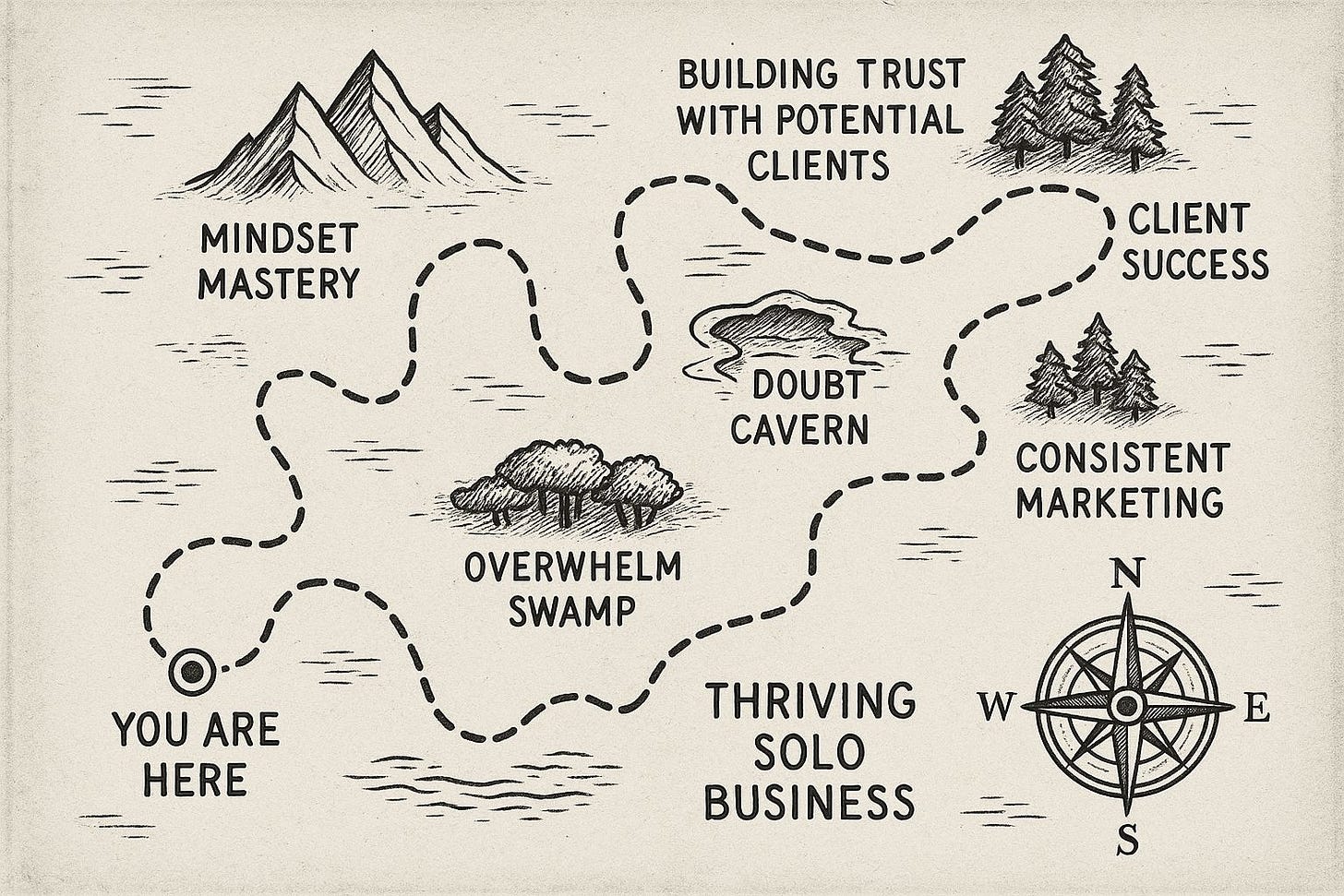Making The Leap: How To Think Like A Business Owner
After decades of showing up for someone else’s dream, stepping into your own business means rewriting the rules—starting with the ones in your head.
You’re Not Just Changing Jobs. You’re Changing Identity.
If you’ve spent 20, 30, maybe even 40 years as an employee, starting your own business can feel like walking into a familiar room where someone changed all the furniture.
At first, it feels exciting. Liberating, even.
No boss. No performance reviews. No mandatory Zoom calls that should’ve been an email.
But before long, a quiet question creeps in:
“Why does this feel harder than I expected?”
Becoming a business owner doesn’t just require a new business card.
It requires a new mindset.
While this realization can seem overwhelming, it is the first obstacle you must overcome to build your business.
I’ll be the first one to admit how comfortable it can feel when you’re an employee. You know the routine. You show up, do your job, and go home. Payday is every week or two. Benefits—covered. Bank some vacation days and try to find the time to use them.
Never mind that you hate your job and wish you were doing something else. Bills still need to be paid.
When you go out on your own, it’s like walking a tightrope without a net. It can be scary because it’s all on you. And you feel all of the ups and downs that come with being your own boss.
That emotional shift is just the beginning. Your thinking also has to evolve.
Employees Think in Terms of Tasks. Owners Think in Terms of Vision.
As an employee, your job was to complete assignments, meet deadlines, and maybe—if you were lucky—offer suggestions at the next team meeting.
But as a solopreneur? You’re the whole team.
You’re doing more than just executing tasks now. Instead, you are prioritizing which tasks matter. You’re building systems, setting priorities, and constantly asking:
“Does this move the business forward?”
It’s no longer about finishing the to-do list.
It’s about choosing the right list to begin with.
I’m used to working on projects. Rolling up my sleeves and getting down in the weeds. That’s my comfort zone. It’s hard to step back from that to focus on the bigger picture. When you wear all the hats, you don’t have the luxury of focusing on the projects you enjoy.
You have to have clarity on the 20% that drives the business. Make that your priority.
Once you’ve clarified your priorities, there’s another shift to make… How you view time itself.
Your Time Isn’t Just Valuable—It’s Capital.
Let’s talk about something most of us were trained not to think about too much: our time.
Employees trade time for a paycheck. That’s the deal. You show up, do the work, and go home.
But business owners?
You’re not just earning money—you’re investing time in something that (ideally) grows in value.
Every hour spent creating a lead magnet, crafting an email, or refining your offer isn’t just labor. It’s equity. The efforts you put in today may not bear fruit immediately, but they are the foundation for long-term success.
That shift—from “I worked X hours” to “I built something valuable”—is uncomfortable at first. But once it clicks, you stop asking, “Am I doing enough?” and start asking:
“Am I building something that lasts?”
The work you put in today could pay dividends for the rest of your life.
There’s No Ladder, Only a Map You Draw Yourself
One of the most jarring things for folks over 50 making this leap is the loss of the ladder.
In traditional jobs, you had titles. Promotions. HR-approved growth paths.
In business? You create your path. And some days it looks more like a winding hiking trail than a career track.
That’s why this shift can feel so unsteady. You’re not failing—you’re just operating without guardrails for the first time.
The good news? You also get to choose your destination.
Just remember that success does not follow a straight line from point A to point B. Embrace the detours as learning opportunities.
So what can make this journey feel less uncertain? Think about what can make the transition smoother.
What Helps the Most?
Here’s what I’ve seen make the biggest difference for solopreneurs in this second act:
Give yourself permission to unlearn.
The habits that served you in corporate life might hold you back now. It’s okay to outgrow them.
You can’t expect to know everything at the start, so embrace the changes.
Trade perfection for progress.
You don’t need to get it “right” the first time. Just get it moving. As one of my mentors once told me, “It’s all an experiment anyway.”
Don’t be afraid to try things to see if they work. You’re free to drop what doesn’t work and double down on what does.
Build a feedback loop, not just a to-do list.
Reflect. Review. Adjust. That’s the rhythm of a business owner.
Become strategic in your approach. Many new business owners chase tactics, but lack an overall strategy to follow. It’s easy to be distracted by shiny objects when you lack clear goals and objectives, both long-term and short-term.
A clear strategy keeps you on track.
Find your people.
This road gets easier when you’re not walking it alone. (Especially when those people also remember life before smartphones.)
Whether it’s a community, your friends, peers, or your partner, it’s important to have folks to share your successes and failures with. Don’t confuse “solo” with “solitary”. You can’t do this in isolation.
There’s real value in helping others on the same path as you. It allows you to learn from each other.
Brainstorming
Masterminds
AI as an assistant
Use tools and community support to make the road less lonely and more sustainable.
Develop and nurture relationships as you grow and establish your community.
Wrapping Up: You’re Not Behind—You’re Rewriting the Playbook
If you’re feeling the friction of this transition, you’re not doing it wrong. You’re doing it honestly.
Shifting from employee to owner is like switching from being a passenger to driving the car. It takes some getting used to—but the freedom is worth every stall and wrong turn.
Write your playbook
Draw your map
And the best part? You’re not too late. You’re right on time.
Every day, I appreciate the career I’ve had. It’s what brought me here and gave me the strength and perseverance to continue. I have no regrets, but if given the chance, I would have started much earlier.
What part of this shift has been the hardest—or most surprising—for you? I’d love to hear your story. Drop a comment and let me know.





Great article Larry! Very clear. One of the biggest adjustments for me was to realize that I still need people to tell me what to do. I've worked with all sorts of business coaches and they help me be accountable and teach me what I don't know.